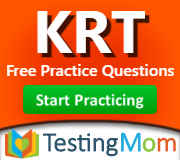The Guide to Preschool and Kindergarten Readiness Tests
| Kindergarten Readiness Test Summary
|
|
|---|---|
| What: Usually a simple demonstration of basic skills that show your child is ready for preschool or kindergarten. | |
| Who: Usually a school official will administer the test. | |
| Where: Readiness tests are usually administered at the school your child will be attending. | |
| When: There is usually a test-taking window before the regular session begins. | |
| How: The administrator will probably have a one-on-one, simple conversation with your child, asking basic questions or asking them to demonstrate skills. | |
| Type: There is a wide range of tests available from the private sector; others may be created by your child's school or the education department of your state. | |
| Why: The tests evaluate your child's school readiness, the skill level of the preschool or kindergarten class as a whole, or indicate whether a child needs special attention. They do NOT usually result in a child being kept away from kindergarten or preschool | |
| Time: Most testing is completed in well under an hour. | |
| Language: Tests are offered in English and Spanish. | |
| Preparation: Basic, regular developmental interaction with your child will probably be all that is necessary for your child to take the test successfully. | |
| Cost: Costs vary; the test is usually free to public school students and may be included in enrollment charges at a private school. Otherwise, costs will most likely be below $50. | |
By Beau Johnson, Tests.com Contributing Writer
Preschool and kindergarten no longer operate exactly the same way as you most likely remember them. Academic research in recent years has found a correlation between an early and rudimentary grasp of fundamental concepts (the three Rs) and greater academic success throughout a child’s education. Preschools and kindergartens act on this information by placing an earlier emphasis on practical education going well beyond familiarization with the ABCs. Children today might even be expected to read small books after only a few months in kindergarten!
The Purpose of Kindergarten and Preschool Readiness Testing
Given the more academically rigorous preschool and kindergarten environment of today, it should come as no surprise that there are multiple examinations to test and determine a child’s intellectual and emotional development before they enter school. A majority of schools (61 percent) test students prior to kindergarten entry, based on data from the Early Childhood Longitudinal Study. But don’t worry about your child “passing” a preschool or kindergarten readiness test; there remains great debate as to whether foreknowledge of letters, numbers and other fundamentals are necessary or even beneficial to preschoolers or to children who are about to enroll in kindergarten. According to the US Department of Education National Center for Education Statistics, most kindergarten readiness or placement tests are actually designed to help individualize kindergarten instruction and/or to identify children who may need special academic instruction or evaluation. Only about a fourth of pre-kindergarten testing is used to support possible recommendation for delaying a child’s entry into kindergarten.
How the Testing is Done
The methods for preschool and kindergarten readiness testing vary widely; there is no universal standard. The particular test or approach may be mandated by each state or by the institution where a child is to be enrolled. According to the Office of Child Development at the University of Pittsburgh, readiness tests come in four types: skill-oriented tests, developmental assessments, quick samplings, and performance-based assessments. Skill-oriented tests are written group exams; developmental assessments evaluate children in terms of expected development at their age; quick samplings assess children’s language skills, motor ability, number skills, body awareness and auditory/visual discrimination; and performance-based assessments use learning portfolios including teacher records and sample work in order to measure educational progress
The majority of preschool or kindergarten entry examinations are likely to be one-to-one, between the school principal or other faculty member, and the child. The tester will usually ask the child a sequence of questions or ask them to demonstrate skills that cover the areas of development in question, such as writing their name, basic counting, identifying letters, looking at an image and describing it, or telling a quick story. The parents will usually wait, and the process should be relatively short—most likely an hour or less. The test may be free, included in other enrollment costs or given for a nominal fee.
Preparation
Because there is usually very little at stake in a kindergarten or preschool readiness test, parents shouldn’t feel pressed to study with their child or train them solely for test-taking purposes. The best way to prepare them for a readiness test is to do normal activities: reading and describing pictures in books, asking questions, getting children to ask parents questions, counting and the like. If a child is shy, it may be helpful to introduce them to the test administrator (if possible) prior to the testing so that they will feel comfortable with the test and the tester.
Without a doubt, any interested parent should contact representatives of their child’s school to find out information about the testing. The school official will know whether testing is done, whether there is a specific test the school uses or whether the state mandates testing, as well as the particulars of the test-taking process.
Need additional, area-specific info on preschool and kindergarten readiness tests? Please take a look at our preschool and kindergarten readiness test directory.




